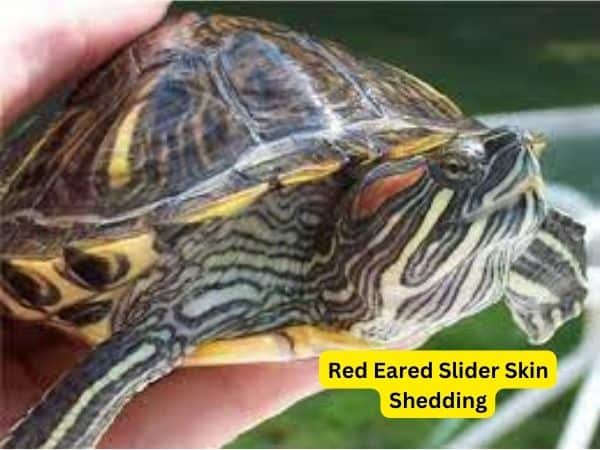Red-eared Slider Turtle Growth Stages
Today we discuss Red-eared Slider Turtle Growth Stages. Ah, the fascinating world of turtles! Have you ever wondered about the growth stages of red-eared slider turtles? These delightful creatures, known for their vibrant red ears, go through intriguing transformations as they mature. So, let’s dive in and explore the captivating journey of red-eared slider turtle growth stages!
From tiny hatchlings to magnificent adults, red-eared slider turtles go through distinct stages in their development. Understanding these stages is essential for turtle enthusiasts and pet owners alike. So, get ready to embark on an exciting adventure as we unravel the secrets behind the growth of these adorable reptiles.
Ready to embark on this learning journey with me? Let’s start by exploring the first stage of a red-eared slider turtle’s growth: hatchlings. Get ready to be amazed by these tiny, pint-sized turtles and discover what makes them so special. Stay tuned for more intriguing facts about the growth stages of red-eared slider turtles!
Understanding the Growth Stages of Red-Eared Slider Turtles:
Red-eared slider turtles are fascinating creatures that undergo distinct growth stages as they develop from hatchlings to adults. These growth stages are crucial for understanding the specific needs and care requirements of these turtles at different points in their lives. In this article, we will delve into the various growth stages of red-eared slider turtles, providing detailed information to help turtle enthusiasts and pet owners ensure the well-being and proper development of these beautiful reptiles.
The Hatchling Stage: Starting Life in a Small Shell
When red-eared slider turtles hatch from their eggs, they emerge as tiny, adorable creatures. At this stage, they are around 1-2 inches long and have soft shells. It is essential to provide proper care during this stage to ensure their survival and healthy growth. Hatchlings should be housed in a temperature-controlled enclosure with clean water and a securely fitted lid to prevent escapes.
It is crucial to maintain water temperatures between 80-85°F to facilitate proper metabolism and growth. A basking spot with a heat source should also be provided to allow the hatchlings to regulate their body temperature. The diet of red-eared slider turtle hatchlings primarily consists of aquatic plants, small insects, and commercial turtle pellets. It is important to ensure a balanced diet to support their growth and development.
During this stage, the hatchlings are extremely vulnerable, and their shells are more susceptible to injury. Avoid rough handling or mishandling of the turtles to prevent any harm. Regular health checks by a veterinarian specializing in reptile care are recommended to ensure that the hatchlings are thriving and to address any potential health issues.
The Juvenile Stage: Growing Bigger and Stronger
As red-eared slider turtles progress from the hatchling stage, they enter the juvenile stage, which marks a period of rapid growth and development. Juvenile turtles range in size from 2-6 inches, and their shells start to harden, providing more protection to their bodies. This stage typically lasts until the turtles reach sexual maturity, which can take several years.
Providing optimal living conditions is crucial during the juvenile stage. Turtles should be housed in a spacious tank or enclosure with an ample swimming area and a basking spot. The water temperature should be maintained between 75-80°F, while the basking spot should have a temperature of around 90-95°F to facilitate digestion and thermoregulation.
The diet of juvenile red-eared sliders should consist of a variety of foods to ensure proper nutrition and growth. This includes a mix of commercial turtle pellets, leafy greens, vegetables, and occasional live or frozen prey items such as small fish or insects. Calcium and vitamin supplements should also be provided to support their bone and shell development.
The Adult Stage: Reaching Maturity and Full Size
Once red-eared slider turtles reach sexual maturity, they enter the adult stage. This stage is characterized by full size and development of secondary sexual characteristics. Female turtles usually reach sexual maturity around 5-7 years of age, while males achieve it at around 2-5 years.
Adult red-eared sliders require spacious enclosures or outdoor ponds to meet their needs. The temperature of the water should be maintained at around 75-78°F, while the basking spot should have a temperature of 85-90°F. Adequate filtration and regular water changes are essential to maintain optimal water quality.
The diet of adult red-eared slider turtles should primarily consist of plant matter, such as leafy greens and aquatic vegetation, with occasional protein sources such as worms, insects, and fish. It is important to avoid overfeeding, as obesity can lead to various health issues. Regular check-ups with a veterinarian are still necessary to ensure the overall health and well-being of adult turtles.
Caring for Red-Eared Slider Turtles in Each Growth Stage
Proper care and attention are vital to ensure the well-being and healthy development of red-eared slider turtles in each growth stage. Here are some essential tips to keep in mind:
Hatchling Stage Care:
1. Provide a temperature-controlled enclosure with clean water and a secure lid.
2. Maintain water temperatures between 80-85°F and provide a basking spot.
3. Feed a balanced diet of aquatic plants, insects, and commercial turtle pellets.
Juvenile Stage Care:
1. House the turtles in a spacious tank with a swimming area and basking spot.
2. Maintain water temperatures between 75-80°F and the basking spot temperature around 90-95°F.
3. Feed a varied diet including commercial turtle pellets, leafy greens, and occasional live prey.
Adult Stage Care:
1. Provide a spacious enclosure or outdoor pond with suitable water and basking temperatures.
2. Ensure proper filtration and regular water changes to maintain water quality.
3. Feed a diet rich in plant matter with occasional protein sources, avoiding overfeeding.
The Importance of Maintaining Optimal Water Quality and Temperature
Water quality and temperature play a vital role in the overall health and well-being of red-eared slider turtles at all growth stages. These reptiles are semi-aquatic and spend a significant amount of time in the water, making it essential to maintain a clean and suitable environment for them.
Ensuring Proper Nutrition for Healthy Growth
Nutrition is a crucial aspect of caring for red-eared slider turtles throughout their growth stages. Providing a well-balanced and varied diet ensures that they receive the necessary nutrients for healthy development and growth.
Socializing and Enrichment for Red-Eared Slider Turtles
While red-eared slider turtles are not social animals, providing them with enrichment activities can enhance their overall well-being. This can include introducing objects in their enclosure to explore, providing hiding spots, and regular interaction with their keepers.
Common Health Issues in Red-Eared Slider Turtles and How to Address Them
Despite proper care, red-eared slider turtles can sometimes experience health issues. It is essential to be aware of these common problems and know how to address them to ensure the well-being of your turtle.
Always Seek Professional Assistance for Specific Concerns
If you have any specific concerns about the growth, behavior, or health of your red-eared slider turtle, it is always recommended to seek professional assistance from a veterinarian with expertise in reptile care. They will be able to provide accurate guidance and ensure the best possible care for your beloved turtle.
Key Takeaways: Red-Eared Slider Turtle Growth Stages
- Red-eared slider turtles go through several growth stages as they mature.
- During the hatchling stage, they are tiny and fragile, measuring only about 1-2 inches in length.
- As juveniles, their shells start to harden and their size increases to around 4-6 inches.
- During the subadult stage, they grow even larger, reaching sizes between 6-8 inches.
- Finally, in adulthood, red-eared slider turtles can grow up to 8-12 inches in length.
Faqs for Red-eared Slider Turtle Growth Stages:
The growth rate of red-eared slider turtles depends on various factors, including diet, water temperature, and genetics. Generally, these turtles grow about 1-2 inches per year during their first few years of life. However, their growth rate slows down as they reach their adult size. It’s important to provide them with a proper diet and a suitable habitat to ensure healthy growth.
Observing the growth of red-eared slider turtles can be a fascinating experience. One way to tell if your turtle is growing is by measuring its length. Use a ruler or a measuring tape to measure the carapace (top shell) from front to back. Keep track of these measurements over time, and you’ll be able to see if there is any growth.
Furthermore, another way to assess growth is by observing if the turtle is shedding its scutes. Scutes are the individual plates on the turtle’s shell. As the turtle grows, it outgrows its old scutes and sheds them, revealing new ones underneath. If you notice your turtle shedding scutes regularly, it’s a clear indication that it is growing.
Red-eared slider turtles reach their approximate adult size between 5 and 7 years of age, although there can be individual variations. By this age, they usually measure 7-9 inches in length.
However, it’s important to note that while they reach their adult size around this time, they may continue to grow in small increments throughout their lifetime.
It’s vital to provide your turtle with adequate space in its habitat to accommodate its adult size. Avoid getting a tank that is only suitable for its current size, as it will likely need more space as it grows older.
Diet plays a crucial role in the growth and overall health of red-eared slider turtles. As they grow, their dietary requirements change. While hatchlings primarily consume protein-rich foods such as small insects and aquatic invertebrates, adult turtles require a more balanced diet.
As your red-eared slider turtle grows, you should gradually introduce more plant matter into its diet. Including leafy greens, vegetables, and commercially available turtle pellets will ensure they receive essential nutrients for healthy growth. It’s important to offer a varied diet to provide a wide range of nutrients.
Male and female red-eared slider turtles typically have slightly different growth rates. In most cases, female turtles tend to grow larger than males. This difference in size is more noticeable once they reach their adult stage. However, keep in mind that individual variations in growth rates can occur, and it’s not a strict rule.
It’s important to note that sex cannot be determined solely based on size or growth rate. If you want to determine the gender of your turtle accurately, you would need to consult a veterinarian or an experienced herpetologist who can analyze factors such as the shape of the tail and the presence of specific physical characteristics.
My Baby Red-Eared Slider’s One Year Growth in One Minute
Summary:
Red-eared slider turtles go through three stages of growth: hatchling, juvenile, and adult.
Hatchlings are tiny and have soft shells, so they need special care and protection.
As juveniles, they grow quickly and their shells harden. A balanced diet is important for their development.
Adult red-eared slider turtles are bigger and fully developed. They need a spacious habitat and a varied diet to stay healthy.
Understanding these growth stages helps turtle owners provide the right care at each stage.


